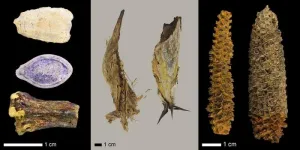(Press-News.org) The El Gigante rockshelter in western Honduras is among only a handful of archaeological sites in the Americas that contain well-preserved botanical remains spanning the last 11,000 years. Considered one of the most important archaeological sites discovered in Central America in the last 40 years, El Gigante was recently nominated as a UNESCO World Heritage site.
“No other location shows, as clearly as El Gigante,” state UNESCO materials about the site’s universal value, “the dynamic character of hunter-gatherer societies, and their adaptive way of life in the Central American highlands, and in Mesoamerica broadly during the early and middle Holocene.”
Now, anthropologists Douglas Kennett and Amber VanDerwarker of UC Santa Barbara, UCSB postdoc Richard George and colleagues from multiple institutions have excavated and analyzed botanical macrofossils — such as maize cobs, avocado seeds or rinds — from El Gigante using modern technologies. Their results are published in the journal PLOS ONE.
“Our work at El Gigante demonstrates that the early use and management of tree crops like wild avocado and plums by at least 11,000 years ago,” Kennett said, “set the stage for the development of later systems of aboriculture that, when combined with field cropping of maize, beans and squash, fueled human population growth, the development of settled agricultural villages and the first urban centers in Mesoamerica after 3,000 years ago.”
The study provides a major update to the chronology of tree and field crop use evident in the El Gigante with 375 radiocarbon dates, finding that tree fruits and squash appeared early, around 11,000 years ago, with most other field crops appearing later in time — maize around 4,500 years, beans around 2,200 years ago. The initial focus on tree fruits and squash, Kennett noted, is consistent with early coevolutionary partnering with humans as seed dispersers in the wake of megafaunal extinction in Central America. Tree crops predominated through much of the Holocene, and there was an overall shift to field crops after 4,000 years ago that was largely driven by increased reliance on maize farming.
“The transition to agriculture is one of the most significant transformations of our Earth’s environmental and cultural history,” Kennett said. “The domestication of plants and animals in multiple independent centers worldwide resulted in a major demographic transition in human populations that fueled the transition to more intensive forms of agriculture during the last 10,000 years. Agriculture also provided the economic foundation for urbanism and the development of state institutions after 5,000 years ago in many of these same regions.”
The botanical materials at El Gigante, remarkably well preserved, reflect the transition from foraging to farming, providing a rare glimpse of early foraging strategies and changes in subsistence. Unique in its location along the southern periphery of Mesoamerica, and for its lower elevation than the dry caves of central Mexico, the authors note, El Gigante serves as a macrobotanical archive for interactions and the flow of domesticated plants between Mesoamerica, Central America and South America. Broader still, it enables researchers to examine the long term evolutionary and demographic processes involved in the domestication of multiple tree and field crops.
“The quality of the plant preservation at El Gigante is simply unmatched, giving us a deeper understanding of how ancient Hondurans managed their forests, domesticated a variety of plant species and intensified their cultivation of key resources over millennia,” said VanDerwarker. “What seems clear is that practices of forest management and field cultivation were closely linked and evolved in tandem.”
And therein, Kennett added, some lessons for modern society can be inferred.
“Our work shows that different types of agricultural systems supported human populations in Central America and that some were more sustainable than others,” he said. “Forest management and arboriculture persisted for thousands of years before it was eclipsed in importance by the expansion of maize farming after 4,000 years ago. The archaeological record provides an archive of human adaptation that should be considered in the context of anthropogenic alteration of our Earth’s climate today. These ancient archives could help rural farmers in Central America adapt to changing conditions moving into the future.”
END
Lessons in sustainability, evolution and human adaptation — courtesy of the Holocene
2023-06-23
ELSE PRESS RELEASES FROM THIS DATE:
New study reveals global reservoirs are becoming emptier
2023-06-23
Water is an essential and indispensable component of humanity’s everyday existence. As the global population grows and the climate warms, so does the water demand.
Over the past two decades, global reservoirs have become increasingly empty despite an overall increase in total storage capacity due to the construction of new reservoirs.
Led by Dr. Huilin Gao, associate professor in the Zachry Department of Civil and Environmental Engineering at Texas A&M University, researchers used a new approach with satellite data to estimate the storage variations ...
Mass General Brigham researchers uncover immune cell marker and regulator of anti-tumor immunity
2023-06-23
B cells are thought to play a critical role in innate and adaptive immunity, but their exact role in anti-tumor immunity remains unknown. Researchers at Brigham and Women’s Hospital with expertise in immunology collaborated with experts in dermatology from Massachusetts General Hospital to further understand the role of B cells and identify a subset of cells that may play a critical role. In collaboration with the Broad Institute they used a technique called single-cell profiling, which allows them to look at all the genes ...
MedTech Innovation Forum Leads Day One at TCT 2023
2023-06-23
NEW YORK & SAN FRANCISCO – June 23, 2023 – Building on the resounding success of last year’s standing-room-only debut, the Cardiovascular Research Foundation (CRF) and Fogarty Innovation are proud to present an even more dynamic and comprehensive TCT MedTech Innovation Forum in 2023. The highly anticipated program will feature additional learning tracks, expanded networking opportunities, increased attendee capacity, and the TCT Shark Tank Innovation Competition. The day-long interactive summit will take place on the first day of TCT 2023 (Transcatheter Cardiovascular Therapeutics), ...
21st century economic growth will be slower than we thought
2023-06-23
Key takeaways:
A new study suggests global future economic growth will be slower than predicted, with developing nations taking longer to close the wealth gap and approach the income of wealthier nations
Governments need to start planning for slower-growth scenarios, which may involve wealthier nations providing lower-income countries with financing for climate change adaptations
National debt and debt-ceiling talks may become more contentious in the coming decades
The global economy will grow slower in the 21st century ...
New analysis: Kaepernick was denied his “right to work” because he, like other Black male athletes before him, challenged structural racism and white supremacy
2023-06-23
A nascent literature is emerging that analyzes the case of Colin Kaepernick who was “locked out” of the National Football League (NFL) beginning in 2017 because he chose to protest police brutality, systemic racism, and white supremacy. Using status expectations states theory and prototypicality theory, this research re-conceptualizes Kaepernick’s lock-out as an infringement on his right to work. First, researchers utilize a modified case-study approach comparing his experiences to those of six other Black male athletes who were “locked out.” Second, researchers utilize data and “matched cases” to demonstrate empirically ...
All the immunity, none of the symptoms
2023-06-23
LA JOLLA (June 23, 2023)—Worldwide, more than a million deaths occur each year due to diarrheal diseases that lead to dehydration and malnutrition. Yet, no vaccine exists to fight or prevent these diseases, which are caused by bacteria like certain strains of E. coli. Instead, people with bacterial infections must rely on the body taking one of two defense strategies: kill the intruders or impair the intruders but keep them around. If the body chooses to impair the bacteria, then the disease can occur without the diarrhea, but the infection can still be transmitted—a process called asymptomatic carriage.
Now, Salk scientists have found that ...
Higher efficiency catalyst key to green hydrogen
2023-06-23
The race to make the widespread use of intermittent renewable energy a reality has taken a step forward with new research by experts from the University of Adelaide who are improving the efficiency of iridium-based catalysts.
“Currently it is difficult for commercial iridium oxide catalysts to achieve high activity and stability at the same time in proton exchange membrane water electrolysis (PEMWE),” said the University of Adelaide’s Associate Professor Yao Zheng, ARC Future Fellow, School of Chemical Engineering.
“We have found that a lattice-water-assisted mechanism – a ...
Drug decelerates bacterial race to antibiotic resistance
2023-06-23
A team of researchers at Baylor College of Medicine is gaining ground in their search for solutions to the global problem of bacterial antibiotic resistance, which was responsible for nearly 1.3 million deaths in 2019.
The team reports in the journal Science Advances a drug that, in laboratory cultures and animal models, significantly reduces the ability of bacteria to develop antibiotic resistance, which might prolong antibiotic effectiveness. The drug, called dequalinium chloride (DEQ), is a proof-of-concept for evolution-slowing drugs.
“Most people with bacterial infections ...
New excess mortality estimates show increases in US rural mortality during second year of COVID-19 pandemic
2023-06-23
Between the first and second year of the COVID-19 pandemic, excess deaths decreased in large metropolitan counties and increased in rural counties in the United States, according to a new study led by Boston University School of Public Health (BUSPH) and The University of Pennsylvania (UPenn).
The novel study presents the first-ever monthly estimates of excess mortality rates for every US county during the first two years of the pandemic.
Excess mortality, which compares observed deaths to the number of deaths that would be expected ...
New excess mortality estimates show increases in US rural deaths during second year of COVID-19 pandemic
2023-06-23
Between the first and second year of the COVID-19 pandemic, excess deaths decreased in large metropolitan counties and increased in rural counties in the United States, according to a new study led by Boston University School of Public Health (BUSPH) and The University of Pennsylvania (UPenn).
The novel study presents the first-ever monthly estimates of excess mortality rates for every US county during the first two years of the pandemic.
Excess mortality, which compares observed deaths to the number of deaths that would be expected under normal conditions in a given ...

